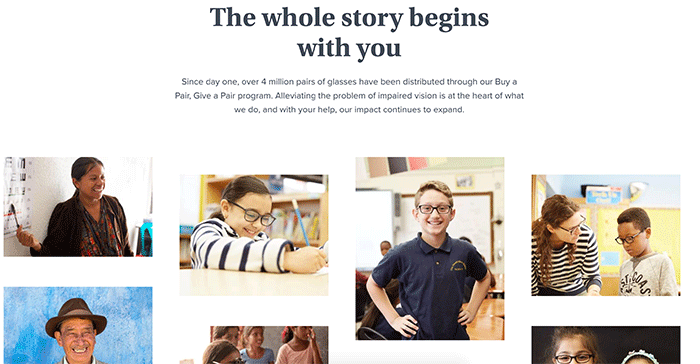4 Shining Examples of Ethical Marketing

4 Shining Examples of Ethical Marketing
In 2016, seventy-five percent (75%) of consumers say they are likely to take negative action against an irresponsible company. Does that still ring true? Learn how to drive awareness, engagement, and success for your ethical marketing strategy.
Updated 5/22/23
Consumers are more socially conscious and eco-friendly every day, so it’s important for brands to consider their social or environmental impact on the world.
According to research from insurance company Aflac, 75% of consumers say they are likely to take negative action against a socially or environmentally irresponsible company. This includes posting on social media, abandoning a brand, or even organizing a boycott.
Ethical marketing allows companies to develop trust with customers in a way that promotes long-term relationships.
View top-ranked digital marketing companies on The Manifest.
What is Ethical Marketing?
Ethical marketing is the philosophy of focusing on both how marketing practices can benefit both your company and social and environmental causes at once.
As more millennials move into leadership and corporate ethics become a mainstay, authentic brands are poised to win big.
Principles of Ethical Marketing
To have an ethical business, companies must consider the following when crafting their marketing efforts and business practices:
- Be transparent
- Commit to sustainability, human rights, and other issues that have a positive impact on the planet.
- Avoid unethical marketing practices by exaggerating and making false claims.
- Respond meaningfully to consumer concerns
- Maximize benefits and minimize risks when it comes to ethical issues.
4 Ethical Marketing Examples
Examine the tactics of three brands whose ethical actions helped them win the trust and market share of a growing customer base that prioritizes core values in their buying choices:
1. Patagonia’s “Don’t Buy This Jacket”
Since “fast fashion” giants like Zara replaced the biannual clothing cycle with a weekly cycle, textile consumption has increased by 400% in two decades, according to the documentary The True Cost.
This trend toward cheap, replaceable fashion has increased environmental pollution and redoubled sweatshop labor in undeveloped countries.
Patagonia insists that people buy less. The premium outdoor clothier has built a reputation for being an ethical brand, environmentally friendly, and unorthodox in its marketing.
Seen below, the “Don’t Buy This Jacket” campaign of 2011 snapped shoppers to attention and compelled them to rethink needless purchasing.

(Source)
“The real message of ‘Don’t Buy This Jacket’ – and it continues to be the real message of Patagonia in terms of consumption – is don’t buy this jacket if you don’t need it,” says Alex Weller, Patagonia’s European Marketing Director.
How is Patagonia an Ethical Marketing Example?
Patagonia’s brand mission is to change people’s relationship to things and encourage them to become more conscious, careful consumers with their marketing materials.
The average American now creates 82 pounds of textile waste per year, so this helps raise awareness and loyalty among a growing pool of conscientious consumers.
Additional Ethical Marketing Examples at Patagonia
The lynchpin of Patagonia’s daring advertising is its dedication to environmental initiatives, such as:
-
Offering free repairs on lifetime warranty products via the Common Threads Initiative
-
Donating all 2017 Black Friday sales (a record $10 million) to grassroots green organizations
-
Pledging 1% of annual sales since 1985 to environmental preservation
-
Switching in 1994 to organically grown cotton to avoid pesticides
These sustainable initiatives also create a unique brand experience. Buying Patagonia lets people feel they’re contributing to a larger movement while making a personal choice to source sustainably.
How to Create an Ethical Marketing Plan
To create an ethical marketing plan, begin with an analysis of your company, customers, and supply chain. Identify ways to source sustainably, remain profitable, and leverage any green initiatives into a marketing advantage.
For example, you can institute a ride-sharing program to reduce the carbon footprint of staff. Or install solar panels and deduct 30% of the cost through the Business Energy Investment Tax Credit.
Ethical marketing can increase costs and see slow returns. Educate your customers to boost your positive reputation, strengthen your brand, and give conscientious consumers more incentive to buy.
2. Dr. Bronner’s Activist Soap(Box)
Dr. Bronner’s was the world’s first certified-organic soap and is now a mainstream success. Since David Bronner became CEO over 15 years ago, annual sales have increased from $5 million to $64 million – a whopping 1,300%.
Bronner’s only “typical” marketing tactic? Driving a psychedelic, soap-spewing fire truck to music festivals.

(Source)
How is Dr. Bonner an Ethical Marketing Example?
Instead, Bronner approaches the family business “on activist terms.”
About half his company profits go to funding hemp and marijuana legalization, income inequality activism, and to fight for free trade and organic standards.
For example, Bronner:
-
Sued the Drug Enforcement Agency in 2004 for banning the hemp oil he’d recently added to his products. He won and the ban was struck down.
-
Sued rivals Kiss My Face and Avalon Organics for falsely advertising their products as organic.
-
Grew fields of palm, coconut, and olive oil when he couldn’t find certified-organic and fair-trade sources.
-
Capped his salary at five times that of the lowest-paid employee. He makes about $200,000 a year as CEO.
-
Refuses to let Walmart carry his soap because he couldn’t tolerate the chain's low worker pay.
How Ethical Marketing Makes a Difference
Such potent advocacy drives huge awareness and loyalty with customers, who feel disempowered about legal issues.
As reported by MarTech Advisor, 88% of consumers say they’re more loyal to brands that support social and environmental causes. Conversely, brands that don’t take a strong stand when called upon – e.g. Uber in the face of Trump’s travel ban – can face serious blowback.
“The activism side of the company enables us to take risks that no sane company would,” Bronner says. “The point of what we are doing is to fight, and the products serve that."
How to Follow Dr. Bonner’s Lead in Ethical Marketing
Take a firm stance to drive awareness and engagement for your brand’s ethics. Develop a strategy around how your strongest customer base feels on key issues, and remember that trying to please everyone will please no one.
Determine how your brand values align with what your target audience is saying, then join the conversation.
This requires a strategic approach to social listening. Faking it can backfire hugely, so identify voices and ideas that resonate with your own.
Include your entire organization and business model here, as it’s everyone’s job to be authentic – not just the marketing department's.
3. Warby Parker Activates the Customer
Warby Parker offers a blend of innovation and corporate responsibility. The company first simplifies the process of finding prescription glasses online, then donates a pair of glasses for each pair purchased.
Since its start in 2010, the “Buy-A-Pair, Give-A-Pair” program has distributed more than 4 million pairs of prescription glass to people in developing countries.
The company makes its customers the focus of the program, as the Buy-A-Pair, Give-A-Pair page shows here.

How is Warby Parker an Ethical Marketing Example?
Positioning customers as agents of change will empower your ethical marketing strategy. This will help you to generate optimal awareness and engagement while helping messaging resonate.
“Bring people along with you; make them feel part of the process of innovation and change,” said Roger Miners, European CMO at corporate investment provider Allianz Global Investors.
What Companies Can Learn From Warby Parker
Tell stories that feature your customer making a difference. This emotional, narrative marketing has worked well for brands like Warby Parker and Toms Shoes for years.
“Show [customers] that as a business you truly live the values you are promoting and that the story you are telling is really yours,” Miner concluded.
Helping customers feel engaged is the fastest way to drive returns from ethical marketing. This way, your marketing never seems boastful and always finds a receptive audience.
4. TOMS Commits to Footwear Philanthropy
TOMS is a very popular shoe brand. What makes the company particularly unique is that its commitment to charity and good deeds are known just as widely as the products themselves.
Among other do-good initiatives, TOMS championed the buy-one-give-one model. This model, along with the company, started up in 2006 and stated that, for every pair of TOMS purchased, one would be donated to people in developing countries.

(Source)
This ethical marketing campaign became wildly popular, making customers feel a direct and clear impact on their purchasing decisions. Not only did TOMS donate shoes, they also contributed the following:
- Helped more than 1,000 students get enrolled in primary school
- Created more than 700 jobs
- Assisted children with malnutrition
- Gave to grants and funds for children and teens
Following TOMS’s success with BOGO giving, the model was replicated by other companies looking to invest in corporate social responsibility.
Due to its long-lived notoriety and impact, many were surprised to see TOMS move away from BOGO ethical marketing in 2019. To date, the company had given away about 100 million pairs of shoes and contributed to various other causes.
Company executives opted to change their one-for-one campaign to donate one-third of their net profit to support grassroots organizations. The business is confident that consumers will recognize this as a way in which the company can help others most directly.
What Companies Can Learn From TOMS
TOMS was able to take ethical marketing to the next level. Even though one-for-one is far more catchy and easy for consumers to understand, the company was more than ready to adjust its model to make a difference.
Evaluate your company and its options to support communities in need. The best path forward will be different for every business. Don’t stick with the status quo if there’s a better solution out there. Reexamine often, and keep supporting others your primary goal with ethical marketing.
How to Succeed With Ethical Marketing
Marketing doesn’t have to be a selfish endeavor. As these brands' examples have shown, your company can do well and do good at once with ethical marketing efforts.
To be most effective, ensure your ethical marketing strategy is customer-driven, strongly voiced, and provocative enough to get attention. Your business decisions would benefit from using ethical marketing examples in this article to further your production process.
Need help connecting with a company? Tell us more about your project, and we'll send you recommendations.
